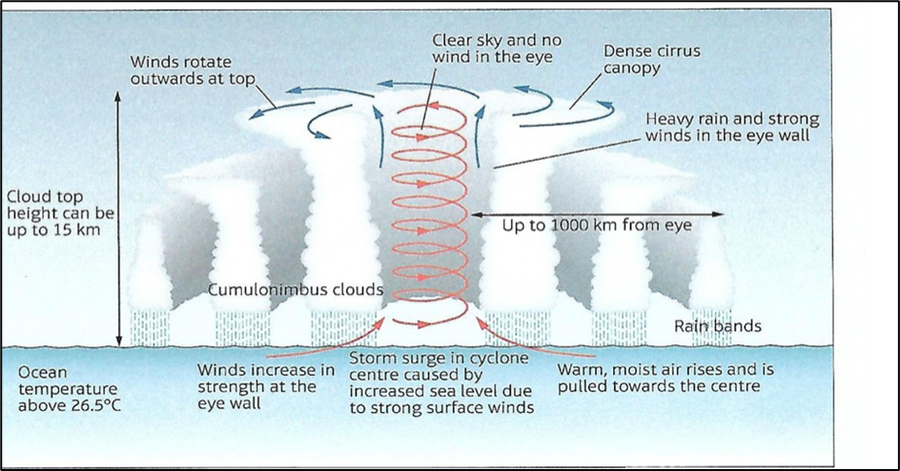Mains Daily Question
June 12, 2023
Explain the formation, characteristics, and impacts of tropical cyclones originating in the Indian Ocean region.
Approach:
Introduction: Introduce by defining the theme of the question, i.e. Cyclones. Briefly bring the context of Indian Ocean cyclones with some characteristics.
Body: Address each part of the question suitably. Write down the process of formation, and characteristics using diagrammatic representation. Briefly write down impacts on the region.
Conclusion: Conclude by suggesting steps to safeguard coastal communities.
Answer:
A tropical cyclone is a rapidly rotating storm originating over tropical oceans from where it draws the energy to develop. It has a low-pressure centre and clouds spiralling towards the eyewall surrounding the "eye", the central part of the system where the weather is normally calm and free of clouds. Its diameter is typically around 200 to 500 km but can reach 1000 km.
Indian Ocean cyclones often have a compact structure with a well-defined eye and can vary in intensity from weak to extremely severe cyclonic storms
Formation of cyclones / Cyclogenesis: Tropical cyclones in the Indian Ocean region typically form over warm ocean waters near the equator. They require specific conditions like:
- Good source of latent heat: Sustained Sea surface temperature of 26-27 deg Celsius for an areal expanse of 60-70 m.
- Presence of Coriolis force: About 65% of cyclogenesis occurs in regions of 5-10 degrees latitude.
- Low vertical wind shearing
Stages of development :
- Tropical Disturbance: This is the initial stage of development characterized by a cluster of thunderstorms with weak or no closed circulation.
- Tropical Depression: If the tropical disturbance becomes more organized with a closed circulation and sustained winds of up to 38 miles per hour (62 kilometres per hour), it is classified as a tropical depression
- Tropical Storm: When the sustained winds of a tropical depression reach speeds between 39-73 miles per hour (63-118 kilometres per hour), it is upgraded to a tropical storm.
- Severe Tropical Storm: It represents a stage between a tropical storm and a tropical cyclone, with sustained winds typically ranging from 48-63 miles per hour (78-102 kilometres per hour).
Characteristics :
- Intense Convection: Indian tropical cyclones are known for their intense convection, characterized by towering thunderstorm clouds that reach high altitudes. This convection leads to heavy rainfall, often resulting in flooding and waterlogging in affected areas.
- Strong Winds: These cyclones are associated with strong winds that can cause extensive damage to infrastructure, uproot trees, and disrupt the power supply. The wind speeds can vary depending on the intensity of the cyclone, ranging from moderate to extremely severe levels.
- Well-Defined Eye: Indian tropical cyclones typically exhibit a well-defined eye at the centre, which is a region of calm and relatively clear skies. This eye is surrounded by a spiral arrangement of thunderstorms known as the eyewall, where the most intense weather conditions occur.
- Cyclone Tracks: Indian tropical cyclones generally follow a predictable track pattern. They often move in a northwest direction, approaching the eastern coast of India and then curving towards the northeast or northwest. However, the exact track can vary, and cyclones can affect different regions along the Indian coastline, including the Bay of Bengal and the Arabian Sea.
Impacts:
The strong winds associated with cyclones can cause extensive damage to infrastructure, uproot trees, and disrupt power supply.
- Loss of life and property: Cyclones can cause widespread damage and destruction, leading to loss of life and property. The strong winds and storm surges can destroy homes, businesses, and infrastructure, and the heavy rains can cause flooding and landslides. Example: Bhola Cyclone – 1970 Bangladesh West Bengal in 1970. It is considered the deadliest cyclone causing around 3-5 lakh deaths.
- Economic disruption: Cyclones can have a devastating impact on the economy of coastal communities. The damage to infrastructure and businesses can lead to job losses and economic hardship. The loss of crops and livestock can also lead to food shortages and price increases. Example: Cyclone Amphan 2020 was the costliest tropical cyclone on record in the North Indian Ocean costing Rs. 1.03 crores in economic loss.
- Environmental damage: Cyclones can cause significant environmental damage. The strong winds and storm surges can erode beaches and coastal wetlands, and the heavy rains can pollute waterways and contaminate drinking water supplies. Example: Cyclone Nivar 2020: Tamil Nadu coast - damaged horticultural crops and mangroves in about 23000 acres.
- Health problems: Cyclones can lead to several health problems, including injuries, respiratory problems, and waterborne diseases. The lack of access to clean water and sanitation can also lead to the spread of diseases. Example: Cyclone Irma (2017): caused malaria outbreaks in Bangladesh.
To mitigate the harmful impacts of tropical cyclones Indian Ocean littoral states should come together such as IONS 2008 to integrate early warning systems, disaster mitigation, response and recovery for enhancing resilience, and provide support to communities affected by cyclones.


